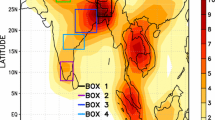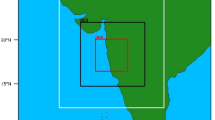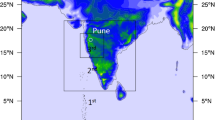Thunderstorm, resulting from vigorous convective activity, is one of the most spectacular weather phenomena in the atmosphere. A common feature of the weather during the pre-monsoon season over the Indo-Gangetic Plain and northeast India is the outburst of severe local convective storms, commonly known as ‘Nor’westers’(as they move from northwest to southeast). The severe thunderstorms associated with thunder, squall lines, lightning and hail cause extensive losses in agricultural, damage to structure and also loss of life. In this paper, sensitivity experiments have been conducted with the Non-hydrostatic Mesoscale Model (NMM) to test the impact of three microphysical schemes in capturing the severe thunderstorm event occurred over Kolkata on 15 May 2009. The results show that the WRF-NMM model with Ferrier microphysical scheme appears to reproduce the cloud and precipitation processes more realistically than other schemes. Also, we have made an attempt to diagnose four severe thunderstorms that occurred during pre-monsoon seasons of 2006, 2007 and 2008 through the simulated radar reflectivity fields from NMM model with Ferrier microphysics scheme and validated the model results with Kolkata Doppler Weather Radar (DWR) observations. Composite radar reflectivity simulated by WRF-NMM model clearly shows the severe thunderstorm movement as observed by DWR imageries, but failed to capture the intensity as in observations. The results of these analyses demonstrated the capability of high resolution WRF-NMM model in the simulation of severe thunderstorm events and determined that the 3 km model improve upon current abilities when it comes to simulating severe thunderstorms over east Indian region.
Similar content being viewed by others
References
Air Weather Service Technical Report 79/006 1990 The use of the skew T, Log P diagram in analysis and forecasting; Air Weather Service, Scott AFB, Illinois.
Bhatnagar A K, Rajesh Rao P, Kalyanasundaram S, Thampi S B, Suresh R and Gupta J P 2003 Doppler radar – A detecting tool and measuring instrument in meteorology; Curr. Sci. 85(3) 256–264.
Chatterjee P, Pradhan D and De U K 2008 Simulation of hailstorm event using mesoscale model MM5 with modified cloud microphysics scheme; Annales Geophysicae 26 3545–3555.
Das Someshwar 1999 Suggested observational network for simulation of cloud processes during the Indian Ocean Experiment (INDOEX); Curr. Sci. 76(7) 912–915.
Ferrier B S, Lin Y, Black T, Rogers E and Di Mego G 2002 Implementation of a new grid-scale cloud and precipitation scheme in the NCEP Eta model; Preprints, 15th Conference on Numerical Weather Prediction, San Antonio, TX, Amer. Meteor. Soc., pp. 280–283.
Hong S Y, Dudhia J and Chen S H 2004 A revised approach to ice microphysical processes for the bulk parameterization of clouds and precipitation; Mon. Weather Rev. 132 103–120.
Huffman G J et al 2007 The TRMM multi-satellite precipitation analysis: Quasi-global, multi-year, combined sensor precipitation estimates at fine scales; J. Hydrometeorol. 8 38–55.
Janjic Z I 1984 Non-linear advection schemes and energy cascade on semi-staggered grids; Mon. Weather Rev. 112 1234–1245.
Janjic Z I 2003 A nonhydrostatic model based on a new approach; Meteorol. Atmos. Phys. 82 271–285.
Johns R H and Doswell C A 1992 Severe local storms forecasting; Weather Forecast. 7 588–612.
Kain J S, Weiss S J, Levit J J, Baldwin M E and Bright D R 2006 Examination of convection-allowing configurations of the WRF model for the prediction of severe convective weather: The SPC/NSSL Spring Program 2004; Weather Forecast. 21(2) 167.
Koch S E, Ferrier B, Stolinga M, Szoke E, Weiss S J and Kain J S 2005 The use of simulated radar reflectivity fields in the diagnosis of mesoscale phenomena from high-resolution WRF model forecasts; Preprints, 11th Conference on Mesoscale Processes, Albuquerque, NM, Amer. Meteor. Soc., CD-ROM, J4J.7.
Litta A J, Chakrapani B and Mohankumar V 2007 Mesoscale simulation of an extreme rainfall event over Mumbai, India, using a high-resolution MM5 model; Meteorol. Appl. 14(3) 291–295.
Litta A J and Mohanty U C 2008 Simulation of a severe thunderstorm event during the field experiment of STORM programme 2006, using WRF-NMM model; Curr. Sci. 95(2) 204–215.
Litta A J, Mohanty U C and Bhan S C 2010 Numerical simulation of a tornado over Ludhiana (India) using WRF-NMM model; Meteorol. Appl. 17 64–75.
Liu C and Moncrieff M W 2007 Sensitivity of cloud-resolving simulations of warm-season convection to cloud microphysics parameterizations; Mon. Weather Rev. 135 2854–2868.
Miller R C 1972 Notes on analysis and severe storm forecasting procedures of the Air Force Global Weather Central AWS TR 200 (revised) Air Weather Service Scott Air Force Base, Illinois.
Mohanty U C, Mandal M and Raman S 2004 Simulation of Orissa Super Cyclone (1999) using PSU/NCAR Mesoscale model; Natural Hazards 31 373–390.
Mohanty U C, Sikka D R, Madan O P and Pareek R S et al 2006 Weather Summary Pilot Experiment of Severe Thunderstorms–Observational and Regional Modeling (STORM) Programme – 2006.
Mohanty U C, Sikka D R, Madan O P and Pareek R S et al 2007 Weather Summary Pilot Experiment of Severe Thunderstorms – Observational and Regional Modeling (STORM) Programme – 2007.
Mohanty U C, Sikka D R, Madan O P, Kiran Prasad S, Litta A J et al 2009 Weather Summary Pilot Experiment of Severe Thunderstorms – Observational and Regional Modeling (STORM) Programme – 2009.
Otkin J A, Huang H L and Seifert A 2006 A comparison of microphysical schemes in the WRF model during a severe weather event; Preprints, 7th Annual WRF User’s Workshop, Boulder, CO.
Otkin J A and Greenwald T J 2008 Comparison of WRF model-simulated and MODIS-derived cloud data; Mon. Weather Rev. 136 1957–1970.
Rajeevan M, Kesarkar A, Thampi S B, Rao T N, Radhakrishna B and Rajasekhar M 2010 Sensitivity of WRF cloud microphysics to simulations of severe thunderstorm event over Southeast India; Ann. Geophys. 28 603–619.
Rao Y V R, Hatwar H R, Salah A K and Sudhakar Y 2007 An experiment using the high resolution eta and WRF models to forecast heavy precipitation over India; Pure Appl. Geophys. 164(8–9) 1593–1615.
Science Plan 2005 Severe Thunderstorms – Observations & Regional Modeling (STROM) Programme; Department of Science & Technology, Government of India, New Delhi, December 2005.
Sen Roy S, Lakshmanan V, Roy Bhowmik S K and Thampi S B 2010 Doppler weather radar based nowcasting of cyclone Ogni; J. Earth Syst. Sci. 119 183–199.
Srivastava K, Roy Bhowmik S K, Sen Roy S, Thampi S B and Reddy Y K 2010 Simulation of high impact convective events over Indian region by ARPS model with assimilation of Doppler weather radar radial velocity and reflectivity; Atmosfera 23 53–73.
Stensrud D J, Bao J W and Warner T T 2000 Using initial condition and model physics perturbations in short-range ensemble simulations of mesoscale convective systems; Mon. Weather Rev. 128 2077–2107.
Szoke E J, Koch S E, Barjenbruch D and Wesley D A 2007 Evaluation of the NCEP WRF NMM and ARW models for some recent high-impact weather events; 22nd Conference on Weather Analysis and Forecasting; 18th Conference on Numerical Weather Prediction, Park City, UT.
Thompson G, Rasmussen R M and Manning K 2004 Explicit forecasts of winter precipitation using an improved bulk microphysics scheme. Part I: Description and sensitivity analysis; Mon. Weather Rev. 132 519–542.
Vaidya S S 2007 Simulation of weather systems over Indian region using mesoscale models; Meteorol. Atmos. Phys. 95 15–26.
Wandishin M S, Mullen S L, Stensrud D J and Brooks H E 2001 Evaluation of a short-range multimodel ensemble system; Mon. Weather Rev. 129 729–747.
Wang Wei and Seaman N L 1997 A comparison study of convective parameterization schemes in a mesoscale model; Mon. Weather Rev. 125 252–278.
Author information
Authors and Affiliations
Corresponding author
Rights and permissions
About this article
Cite this article
Litta, A.J., Mohanty, U.C. & Idicula, S.M. The diagnosis of severe thunderstorms with high-resolution WRF model. J Earth Syst Sci 121, 297–316 (2012). https://doi.org/10.1007/s12040-012-0165-y
Received:
Revised:
Accepted:
Published:
Issue Date:
DOI: https://doi.org/10.1007/s12040-012-0165-y




